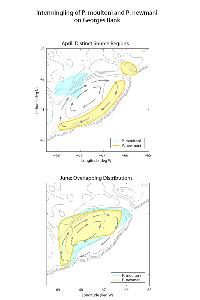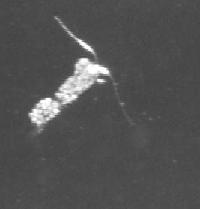
Enlarge image |
Intermingling of P. moultoni and P. newmani during the growing season on Georges Bank. The clockwise circulation on Georges bank is depicted by arrows. Link to publication
| 
Enlarge image |
image courtesy of Cabell Davis, Woods Hole Oceanographic Institution
|
Coastal Circulation and Zooplankton Population Dynamics
What processes control the distribution and variability of keystone zooplankton species in the coastal ocean? The U.S. Globec program has offered an outstanding opportunity to study the oceanographic ecology of two of the most abundant calanoid copepods on Georges Bank, Calanus finmarchicus and Pseudocalanus spp. These organisms are interesting not only because of their key role in the food web, but also because their younger stages are preferred prey items for larval cod and haddock, thus potentially linking variability in recruitment of commercially important fish stocks with fluctuations in the abundance of these copepods. My work in the Globec program has focused on using coupled physical-biological models together with observations as a framework for dissection of the manifold contributions to structure in population distributions. The utility of this approach is predicated on an ability to construct a simulation that is representative of the natural system. One technique for doing so (the problem) is to initialize a coupled model with a set of observations, integrate forward in time and then compare with the next set of observations. A successful outcome results in minor discrepancies between observations and predictions, and the model solutions thus can be used as a basis for diagnosis of the processes controlling the observed changes in abundance (e.g., Lynch et al., 1998). Unfortunately, satisfactory solution of the forward problem is not always achievable due to limitations in the models, the observations, or both. Inverse methods provide an alternative approach that is particularly useful in such cases. These techniques can be used to determine the model inputs (e.g., parameters, forcing functions, etc.) that minimize the misfit between observations and predictions, thereby producing an optimal solution from which the underlying dynamics can be gleaned. My initial attempts to simulate the seasonal variations in abundance of Pseudocalanus spp. with a forward modeling approach were not successful, in that the results were demonstrably inconsistent with observations. With little information to guide improvements of the forward model to make the simulations more consistent with the data, I decided to pursue the inverse question: what are the biological sources and sinks implied by the observed changes in abundance given the circulation during the intervening period? The problem is posed mathematically as an advection-diffusion-reaction equation for a scalar variable. Given an initial distribution of animals, we seek the population dynamics source term such that integration of the forward model will result in predictions that minimize the sum of squares of differences with observed concentrations at a later time. I designed an adjoint data assimilation technique for these purposes, and have applied it to two major studies of Pseudocalanus in the region (McGillicuddy et al., 1998b ; McGillicuddy and Bucklin, 2002). The results reveal spatial patterns in the inferred source/sink term that vary seasonally according to the animal distributions, the currents, and their orientation with respect to each other. In cases when the flow is either weak or aligned with gradients in organism abundance, changes in concentration over time are dominated by local population dynamics. In situations where the currents are normal to these gradients, complex three-way balances arise between the local tendency, advective transport, and the source/sink term. Diffusion does not appear to play a major role in these simulations. Generally speaking, the magnitudes of the inferred sources and sinks are not inconsistent with direct rate measurements of population dynamics processes such as reproduction and mortality. Based on the inverse solutions, it is possible to distill conceptual models of the oceanographic ecology of Pseudocalanus in this region. For example, inversion of the large-scale climatological distributions of Pseudocalanus spp. using the Marine Assessment Monitoring and Prediction (MARMAP) data suggested that the population centers located in the western Gulf of Maine and on Georges Bank may be self-sustaining, in contrast to prior studies which characterize the former as a source region for the latter (McGillicuddy et al., 1998b). Assimilation of molecular genetic information from Globec surveys (Bucklin et al., 2001) has revealed that the two species of Pseudocalanus in this region have distinct population centers in the late winter/early spring: P. moultoni on the northwest flank of Georges Bank, and P. newmani on the Northeast Peak and the southern tip of Browns Bank. As the growing season progresses, the clockwise circulation around Georges Bank blends reproducing animals from the two source regions, causing their distributions to overlap by early summer (McGillicuddy and Bucklin, 2002). Two main conclusions arise from these studies. First, species-specific population dynamics are necessary to resolve the underlying physical-biological interactions. Second, advection plays a critical role in determining the distribution and abundance of these organisms, with fundamental implications with respect to the ability of these populations to sustain themselves regionally. Related links Real-time Modeling on Cruises EN323 and EN324-May-June 1999 Dartmouth Numerical Methods Laboratory U.S. Globec Northwest Atlantic / Georges Bank Study U.S. Globec Program |
